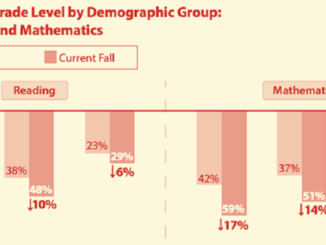
For those of us who favor a welcoming society, where a regulated legal flow of immigrants helps grow the economy, we need to take seriously the concerns of those in this country who fear America is becoming a land of parallel universes. Otherwise, the pushback against immigration might only intensify, with opponents convinced that no one hears their concerns about America becoming a splintered nation.
One of those worries — understandably — is that English will slip away as a unifying force in our country.
This anxiety is more than a passing one. The National Center for Education Statistics reports that nearly one in 10 U.S. public school students was learning English as a second language in 2015, and that number is projected to increase. In Texas, about 17 percent of students already qualify as English-language learners. In California, that figure is 21 percent.
What’s more, according to the Bush Institute’s latest version of America’s Advantage: A Handbook on Immigration and Economic Growth, about half of the U.S. foreign-born population reports speaking English “less than very well.”
To be sure, those percentages improve for second- and third-generation immigrant families. The Pew Research Center reports that 75 percent of third or higher generations of self-identified Hispanics say English is their dominant language. Still, finding the best ways for immigrant students to become proficient in English should be an important national goal.
A mastery of English certainly will benefit students. English, after all, is the language of the marketplace, the workforce and the culture. Being proficient in it will increase a student’s chances of economic and social mobility. In fact, a Cato Institute study shows that English fluency boosts wages of immigrants by 21 percent and is a good predictor of future wages.
Becoming adept at English doesn’t mean speaking only English. We should encourage all students to become proficient in at least two languages, as a number of states and districts do. Daniel King, superintendent of the respected Pharr-San Juan-Alamo school district along the Texas-Mexico border, proudly describes his district as being biliterate.
There is a good reason to be proud of biliteracy. A facility in more than one language can lead to a mastery of other subjects. A 2017 report from the National Academies of Sciences, Engineering, and Medicine explains that children who are competent in two languages have cognitive advantages in planning, regulating their behavior and thinking in a flexible way.
What works
The good news is that survey data from organizations like the Pew Hispanic Center show the desire to learn English is strong among many immigrants. The challenge is making sure they have effective programs and qualified instructors.
The literature about acquiring English and those who specialize in the field say dual-language classes particularly can help elementary-age students who do not know English — or know it well. To its credit, the Dallas school district employs this strategy in more than 150 schools. And districts in places like Denver, San Francisco and New York use this approach, including for native English-speakers.
Various models of dual-language learning exist. A common approach is one-way dual language, where only non-English speakers participate in the classes, learning English while also mastering core subjects in English and their native language.
Another strategy is two-way dual-language instruction, which involves both English and non-English speakers. For example, native English-speakers learn academic content in both English and a foreign language, often Spanish. The reverse is true for students who are not native-English speakers. (My children participated in this type of program for several years.)
The campus also can split up the day or week with half the instruction in English and half in Spanish, or use some other percentages.
However the dual-language model is used, what’s important is that schools are elevating language. The focus needs to be on integrating the learning of a language into the culture of the campus. Paige Ware, an education professor at Southern Methodist University, concentrates in English-language learning strategies. The former English as a second language instructor says that results improve if the entire school embraces the multilingual approach, weaving language into other classes as well.
For example, the entire school should learn and use the same word in all classes throughout the day. This technique gets students to use vocabulary in many different situations.
Encouraging the entire school to embrace the learning of a language should extend to parents as well. Delia Pompa, a senior fellow at the Migration Policy Institute who works on improving education services for immigrant students and English-language learners, emphasizes that schools should make a point of including parents, even if they do not speak English. Just talking to children at home helps them learn words, whatever the language.
Sheltered immersion is another way to help students acquire English, especially if they transfer into a U.S. school in their teenage years without knowing the language. Students are taught in a standalone classroom with a focus on learning English. This approach is sometimes a necessity.
What’s needed
A state or district can have all the right strategies, but still will need qualified instructors to execute them. Finding those teachers is a challenge from New York to Texas to California. The Dallas school district recruits at universities across Texas and has a partnership with the University of North Texas-Dallas in its attempt to hire more bilingual instructors. “There is a national competition,” Dallas school trustee Edwin Flores told me.
We hear a lot about school funding shortfalls. This is one area where state investments could make a big difference. The dollars could help districts hire and train both teachers and principals for the populations that educators increasingly are asked to serve, as well as develop appropriate curriculum. More financial support from Washington, which helps states with their bilingual students, could make a difference, too.
My point is not to write a manual on language instruction, but rather to emphasize that the right strategies can help integrate immigrant students into the larger mainstream. As that happens, some of the anxieties about the nation’s identity can be abated.
We then can see that these students represent an opportunity, not a threat to our way of life. As Flores says, they possess the ability to work in diverse settings, from large hospitals to international businesses to local shops — or wherever familiarity with different languages and cultures matters. In an increasingly globalized world, our economic prospects are undoubtedly enhanced by Americans who also speak Spanish, Chinese or Korean, among other languages.
At the same, time, we can find new ways to live together. This is all about moving beyond division and toward a realization of e pluribus unum — out of many, one.
William McKenzie is editor of The Catalyst: A Journal of Ideas from the Bush Institute. Email: [email protected]



